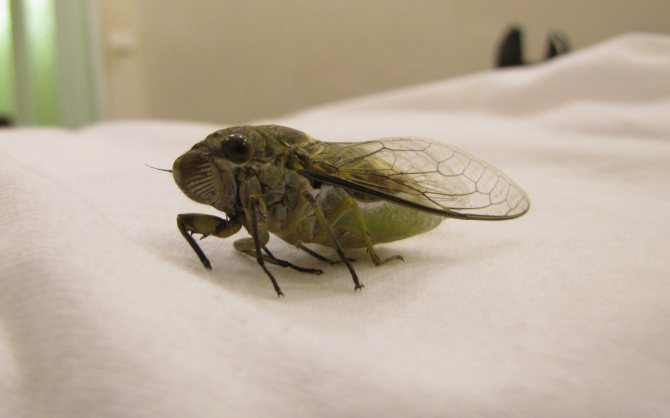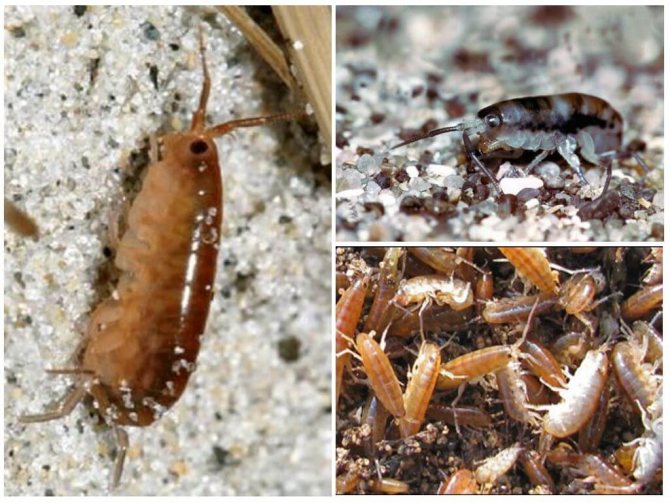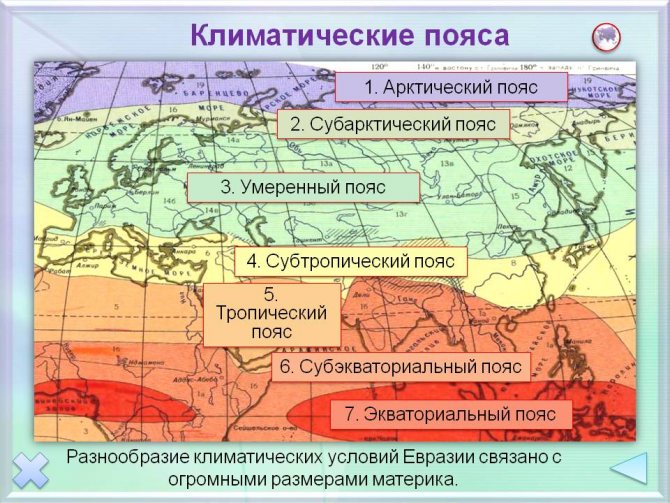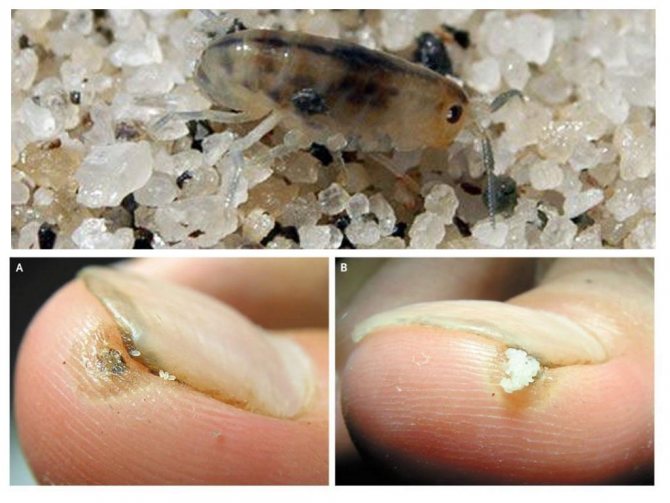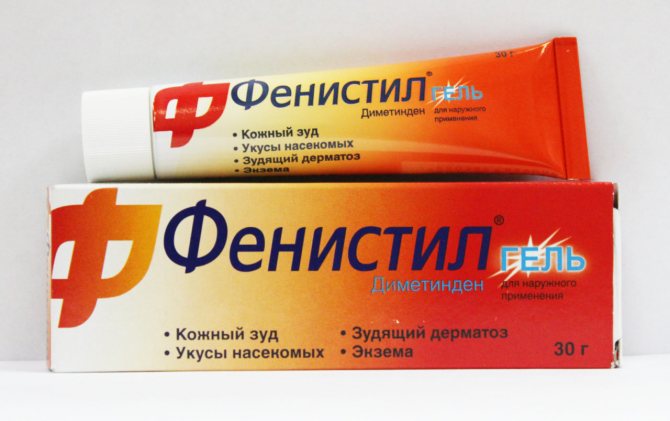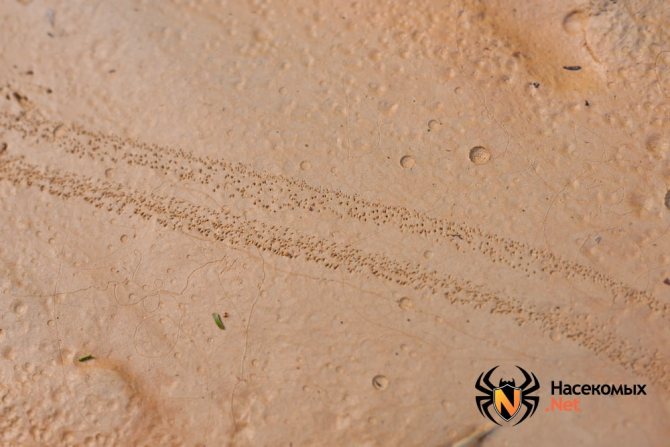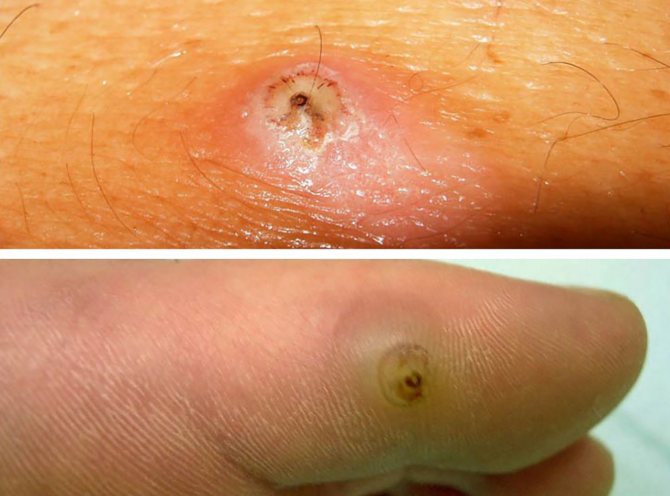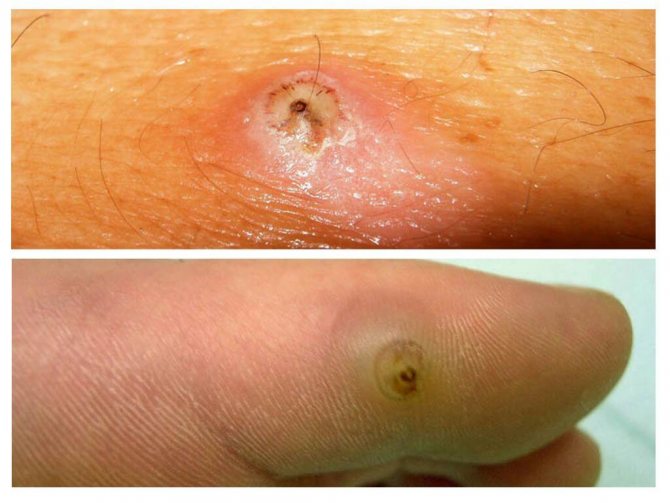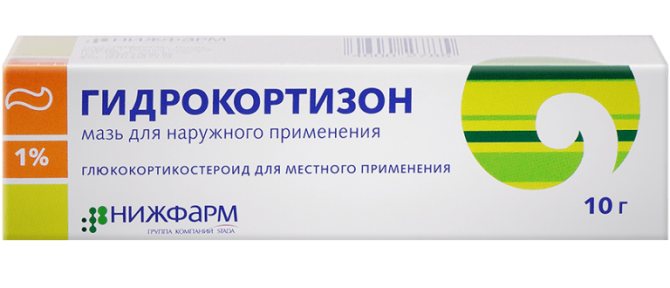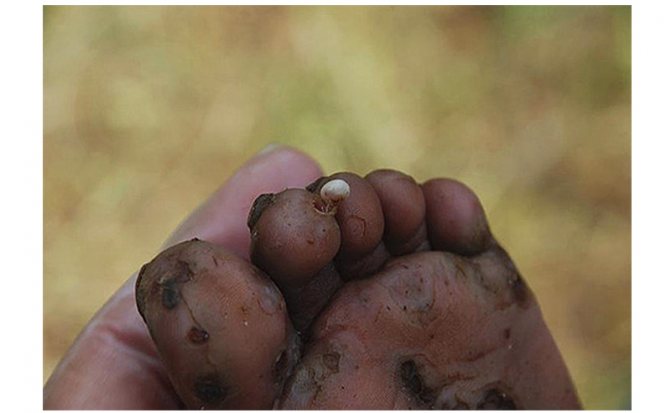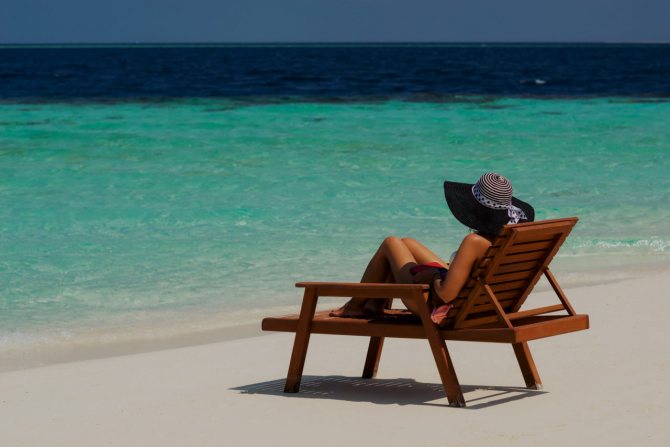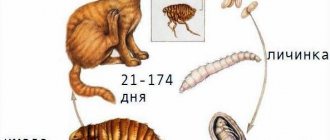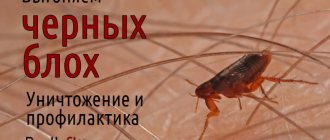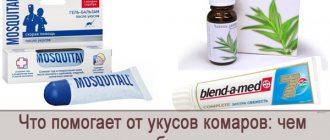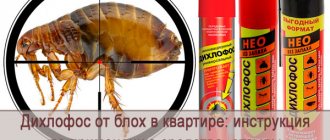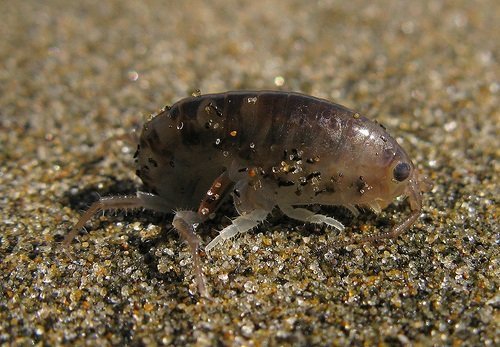
The sand flea is a southern inhabitant. It is most commonly found in African countries and the Caribbean. However, upon returning from another vacation from the warm seas of Vietnam or Thailand, it is not at all difficult for a person to accidentally bring with him a couple of specimens of this species. Therefore, it is very important to know how the lesions look after bites, as well as what measures to take in order to competently deal with the scourge and avoid serious problems.
How do they look
Small parasites visually resemble a dark moving dot. They are confused with ants, bugs, midges. A distinctive feature of the insect is jumping ability. Small, bouncing crumbs on the beach are a sign that the area is infested with fleas.
You need to know the enemy by sight:
- Adults reach a length of 1.5 to 2 mm.
- The color is dark brown, sometimes with a reddish tint, depending on the habitat.
- Sand fleas have six legs. The hind ones are longer, with the help of them they push off and make a jump up to 40 cm long. This is 200 times the body length.
- The body is in the form of a flat droplet, protected by a shell and covered with scales that allow it to cling to any surface.
- Females are larger than males. When eggs are carried, their sizes increase.
Sand Flea Bite Treatments
One of the obvious symptoms of a bite is swelling and unbearable scabies. Before applying medications, the wound must be disinfected. For these purposes, hydrogen peroxide is suitable. After this procedure, you can use medications to help get rid of discomfort. They come in three forms:
- cream;
- spray repellent;
- pills.
Each remedy is effective at different stages, depending on the scale of the disaster and the size of the bite.
The most popular antihistamine creams are:
- yellow balzam;
- Phenergan cream;
- Fenistil;
- Compound Dexamethasone Acetate Cream.


They perfectly relieve itching and pain, after which the desire to comb the body disappears, in addition, they are suitable for children. To eliminate scabies and inflammation, hormonal agents based on hydrocortisone or sulfuric ointment can also be used. Aloe Vera preparations will have a calming effect.
Of the repellent sprays, Mentholatum Remos is the most effective.
Its effect lasts up to 6 hours. In addition, it is suitable for children from 4 years of age. You can also use Calamine lotion. This antiseptic will speed up the healing process.
The tablets are divided into antihistamines and antibiotics. Among antihistamines, cetirizine hydrochloride 10 mg (Cetirizine Hydrochloride) is effective. Suprastin and Zyrtec have a lesser effect. These medicines reduce scabies, but are contraindicated in children under 7 years of age.
Antibiotics reduce lesions and itching, but work more slowly than cream. For example, when taking Hapenxin XX 500mg in capsules, changes become noticeable only after 5-7 days, and a complete cure occurs after 7-8 weeks. As a rule, both types of tablets are used in combination. The downside is that medications can make you drowsy.
Traditional methods of getting rid of the effects of bites
In addition to medicinal products, there are effective folk remedies to eliminate itching after a bite. Their essence boils down to the effect of high temperatures on the affected area.
- If you send a hot stream of a hair dryer to the bite site, you can feel relief. True, you need to blow carefully. Otherwise, you may get burned.
- Instead of a hair dryer, you can use hot cutlery - knives, spoons or forks. The device is placed in boiling water for a couple of seconds, and then applied to the affected area.
- Another alternative is a hot shower. You need to turn on the temperature, which is almost unbearable to endure. Of course, the skin will turn red, but after being dried and moisturized with the cream, the itching will go away.
Habitat and methods of infection
Sand fleas prefer humid tropical climates. The habitat is the countries of Asia - Thailand, Cambodia, Vietnam, Indonesia and part of China. West Africa, India also provide favorable conditions for the habitation of parasites.
You can only get infected in the countries of residence. Insects are sensitive to climate and lack adaptive abilities. If they are brought to another country that does not have a tropical climate, they will not survive.
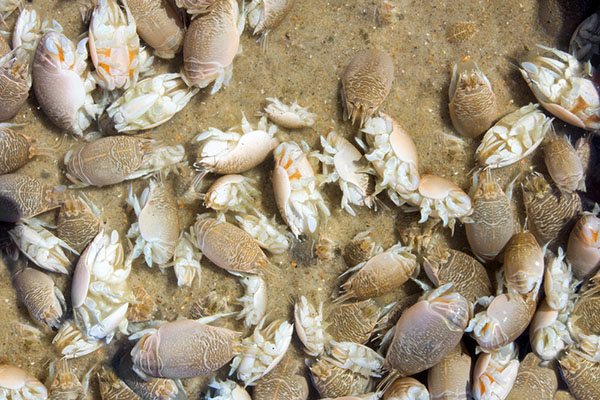

In Cuba, sand fleas await victims on wild beaches during excursions to local areas. A walk through the souvenir shops in the coastal town can turn into a meeting with a parasite. If you look closely, you can see traces of sand flea bites on the feet of local residents.
In India, which is not the most cultured and cleanest state, it is easier to meet sand fleas. On the territories of the most popular resorts: in Goa, Kerala, a large number of local residents who come from the surrounding area and bring sand fleas with them rest and work. Unsanitary conditions, lack of proper maintenance of clean beaches and preventive measures aimed at the destruction of insects contribute to their reproduction.
Thailand is a state in which modern megacities are located next to the countryside. In Bangkok, you can easily meet sand fleas when walking in a poor area or on a wild beach. In the "Land of Smiles" tourists make up the lion's share of the state's income, so the resort recreation areas are carefully monitored.
Vietnam, Phu Quoc Island is no exception. Walking to distant resting places and coastal villages increases the chances of encountering sand fleas.
In the Dominican Republic, beaches are the habitat. Street dogs that love to feed there are carriers of sand fleas. It is better to avoid places of congestion of animals.
The infection is most often affected by the poor, who live in remote areas of Asian countries. People, due to the lack of funds for medical care and disinfection, are forced to endure an unpleasant neighborhood with insects all their lives.
On beaches, resort areas, busy areas, areas owned by hotels, insecticide treatment is carried out, which destroys or temporarily restrains insect attacks. Flea control activities by the hotels are confidential. Hardly anyone wants to go to a hotel with parasites. You can find out about the problems only through reviews of tourists who have visited a resort or a particular hotel.
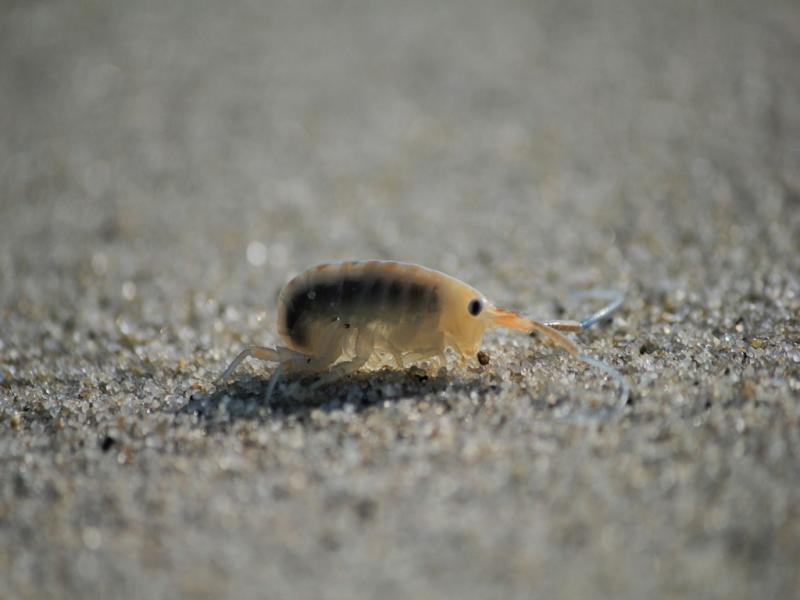

Infected:
- On the coast, beaches, in places where stray animals are concentrated. The peak of activity is in the early morning and sunset. It is better to spend these hours elsewhere.
- Guided tours. Trips to inspect the way of life of the local population can turn into a meeting with fleas.
- Thickets of grass. Important! If you decide to go for a walk, then be sure to wear boots and long pants.
"Favorite" places for a parasite bite are fingers, under nails, less often - armpits, groin area.
Life cycle
The life cycle of the insect in question is divided into 4 stages:
- The female lays eggs (about 300 at a time), which are round and oblong, light in color. Eggs develop in 1.5–2 weeks.
- The worm-like larva, about 4 millimeters long, lives in this form for two weeks, feeding on organic debris. After it grows over with a cocoon and takes the form of a pupa.
- Three weeks later, an adult flea is born from the pupa (if the external environmental conditions are unfavorable, then the insect can stay in the pupal state for up to six months).
- Standard adult life.


Breeding cycle
The eggs hatch under the human skin. That is, the pregnant female pierces the skin and gets inside, reaching the blood vessels and sucking on them.
After the eggs are born, the flea dies within 10 days, but it is important to understand that each adult can survive for almost six months.
Typical symptoms
Sand flea bites are easily confused with mosquitoes. Visually, they look like a slight redness on the skin, with a small tubercle. The intensity of the itching is much stronger, and after the "unrelenting desire" to scratch, you should be on your guard. After 3-8 hours, the bite site increases in size, brings pain when touched, burning.
Male bites are less problematic - only a red bump remains, which itches. Females, in addition to being bitten, can harm by laying eggs in the wound. For laying, the female "digs" a tunnel in the dermis, feeding on blood from the vessels. This causes severe inflammation, pain. Visually, the bite site is large in size, at the base of which you can see a black dot - the body of the female and pus.
What to do if the insect is still bitten
It is important not to touch itchy areas. Otherwise, the area of irritation will increase, and fluid will begin to ooze from the bite. The most unfortunate way is to give up the problem without making any attempts to cure it. You cannot think that the reaction to the bite will go away in a few days. The insidiousness is that the longer the insect is under the skin, the stronger the inflammatory process.
In no case should you self-medicate, remove the body with improvised means. The flea is located next to the vessels, and if you accidentally crush it, clumsily pulling it out, complications cannot be avoided. The female can only be removed promptly. The surgeon removes the insect with tweezers or sterile needles, treats the wound and bandages the operated area. If help is provided on time, the outcome is favorable.
So the best thing on vacation is to go to the hospital for health insurance.
Possible consequences of a bite
The consequences of a bite, and how they are dangerous:
- They bring painful sensations. If the itching caused by sand flea bites is not stopped with a special remedy, they turn into wounds and increase in size.
- Sepsis is blood poisoning. Combing, given the hot climate, makes it possible for the active reproduction of microorganisms in the wound.
- Allergy. It manifests itself as a rash, increased tissue edema. Quincke's edema is a rare but possible response.
- Elephantiasis. Swelling and inflammation of tissues leads to stagnation of lymph, a decrease in blood circulation and pathological edema, which turns into a serious illness.
- Strong scratching of the wound leads to the death of tissue cells and traumatic (mechanical) necrosis.
- Deformation of the fingers and nail plates. "Favorite" bite of sand fleas - fingers, the area between them. Severe inflammation goes deep into the wound site of the skin, causing irreversible consequences in appearance.
- Tetanus is a dangerous disease that affects the nervous system. Leads to painful cramps in the limbs, in some cases - death.
- Ulcers. The infection spreads over the skin, causing ulcerative rashes throughout the body.
- Tungiosis.
- Late treatment leads to the formation of a deep wound - a fistula that heals for a long time, leaving a scar.


What diseases do beach fleas carry?
Sand fleas sanyaparasitizing under the skin, can provoke deformity of the toes or hands, elephantiasis, tissue necrosis or thrombophlebitis. Parasites bite not only people, but also animals - rabbits, dogs, cats, goats. It is worth saying that each person, depending on the individual defenses of the body, reacts in a special way to the bite of a bloodsucker. One may not even notice anything except a slight itching, while the other may experience a severe painful shock, very unpleasant symptoms. Due to the fact that midges are blood-sucking insects that feed on the blood of humans and animals, they are considered carriers of all kinds of infectious and viral diseases. Beach fleas in China can provoke the occurrence of a rare, exotic disease in a foreign tourist, which he will bring home. This is how viruses and infections spread around the world.
Important! Symptoms of sand flea penetration under the skin can appear only after 8-10 days, when it significantly increases in size. If an infection enters the site of the bite, then during this time blood poisoning can rapidly develop, which will lead to the death of a person.
Treatment
It consists in antiseptic treatment, removal of edema and itching. If the female has laid eggs in the wound, you should see a doctor right away. It is dangerous to carry out removal manipulations on your own - the consequences can be very serious.
Means for treatment:
- Pain relievers, cooling ointments and sprays.
- Antihistamine ointments or tablets.
- Antiseptics.
For the treatment of contaminated premises, special disinfectants are sold in the form of sprays, ampoules and solutions. All remedies and remedies are sold in local shops and pharmacies.
Unfortunately, there is no vaccine to help avoid the consequences of sand flea bites.
Reproduction
The process of intercourse of insects can last several hours. Females have a uterus and ovaries. Males own a genital organ called a genital claw. During mating, the female is on the back of the male and pulls the seminal receptacle into herself. It takes about 15-20 minutes for the genetic makeup to reach the uterus.
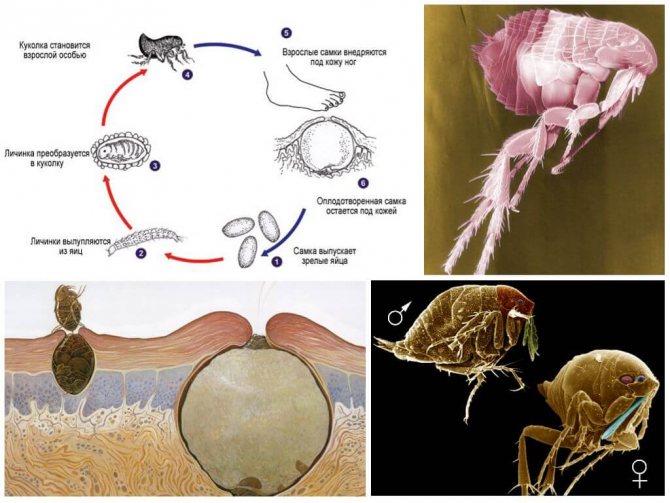

The only condition for a successful conception is having access to food. For this reason, on the eve of intercourse, the female feeds on the host's blood so that she has enough strength to mate. Immediately after the process, the individual also eats, food gives it energy, accelerates the process of egg maturation. If conditions are favorable, a flea can lay several groups of larvae per day. Most often, it is removed from the wound before the moment of birth.
Precautions
In order not to think about how to get rid of sand fleas, it is better to prevent this. Simple rules will minimize the risk or avoid infection altogether:
- After arriving in a place where there are fleas, immediately start using the sand flea protection product. There are repellents, sunscreens with a repellent scent that you can buy everywhere.
- You can protect yourself from sand flea bites by wearing shoes on the beach and sunbathing on sun loungers.
- Avoid visiting places where the likelihood of infection is high: wild beaches, local settlements, poor areas and places where stray animals gather.
Sand fleas - where do they come from and why are they dangerous?
Insects belong to the genus Tunga. The second name is considered "earthen flea". They are listed as distant relatives of rat and feline parasites. The width of the body does not exceed 1 mm, and the length is 1-2 millimeters. The brown shell is very strong, so it is unlikely that it will be possible to crush a flea with a fingernail. The parasites do not have wings, but they can reach from 14 to 36 cm in a jump. The larvae of insects resemble small worms. Habitat - grass, hut floors, garbage cans.


In addition to humans, the victims of pathogens are domestic animals - dogs and cats, as well as cattle such as sheep, horses and mules. Possible attacks on monkeys, mice, elephants, pigs.
According to statistics, fleas often attack those who do not wear shoes.Women suffer from bites less often than men. An outbreak of insect attacks is recorded in September. But in January you will hardly find parasites. By the way, these creatures of God bite people selectively. Out of 5-6 people who are close to each other, they can attack only one.
The danger is that as a result of the bite of a female sand flea, you can lose your fingers and even die. More about this will be discussed below.
How to extract a flea, video
In no case should you try to get the body of the female, which is sticking out. You run the risk of contracting a dangerous infection that can become a serious cause of health problems. You need to immediately seek help from professionals at the hospital, who will help you cope with the trouble with a surgical procedure.
See what the sand fleas look like in the video as they penetrate human skin. You will understand why you do not need to pull them out on your own. Do not hesitate to contact a specialist, because this can result in unpleasant consequences.
Can they live in an apartment
In various regions of Russia, there are many types of fleas that can get into the room, even though there are no pets. The most common types are:
- Household fleas that are carried by animals into an apartment can bite people; Fleas
- Basements (bugs up to 0.5 cm in size), penetrating from the basement or entrance to the living quarters on the lower floors;
- Bed (white), living right in the bed;
- Sand fleas in the apartment are very rare and only on the Crimean peninsula, but there they are not as dangerous as their overseas brothers.
Recommendations for tourists leaving to sunbathe in the southern countries: take with you creams and ointments from harmful insects and more. Enjoy your stay!
How to recognize an insect bite


A tourist who has been bitten by a sand flea may be unaware of anything for at least a few more hours. The maximum incubation period is 12 days.
We suggest that you familiarize yourself with: How to destroy bed fleas
The very moment of the bite is not felt in any way, and the dimensions of the insect, as mentioned above, do not exceed a few millimeters, so it is difficult to notice a flea. They live on dry and wet sandy beaches. At the same time, it does not matter whether a deserted place or a crowded place - insects will always find a victim.
How to recognize a sand flea bite?
- The skin starts to itch.
- Most often, limbs itch - legs, especially feet, and hands. Damage to the trunk is not excluded - neck, back, abdomen, groin. The genitals, lips, and the back of the head may be affected.
- Over time, the itching becomes more intense, and the bite marks become obvious. They are larger in size than mosquitoes, and the affected area swells like a bump. In the center, a clear point is clearly visible - the body of the insect.
- If the degree of attack is low, then there are no more than 5 lesions, and with the maximum form, more than 30.
- A severe form of invasion is more common among people of retirement age.
Those who are not particularly versed can easily confuse a flea bite with the way a bug bites. But the difference is that after the bite of the latter, no cones remain, but they mainly affect the legs.

